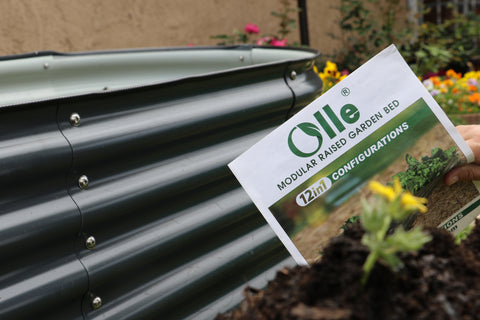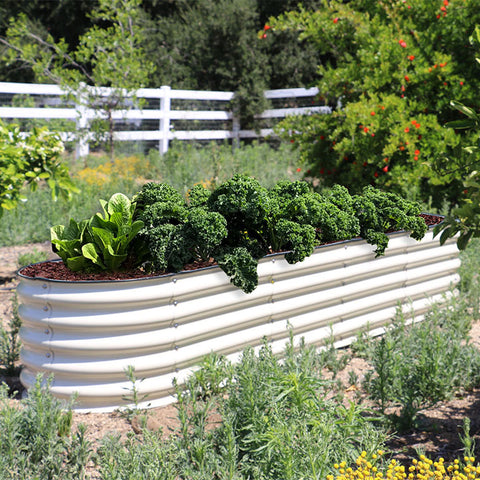Tips from Olle Garden Bed: Effective Methods For Removing Whitefly
Whitefly is a small flying insect that can quickly infect your garden plants and indoor plants. Whiteflies quickly damage vegetables and plants by sucking on their juice. These white winged insects also damage plants by infecting diseases and causing ash mold to grow on plant leaves. The following content also has some reference value for raised garden beds.
Whiteflies attack vegetable plants such as cabbage, citrus trees, eggplants, and potatoes. These tiny white caterpillars will also quickly invade greenhouse plants such as tomatoes.

What does a whitefly look like?
The whitefly looks like a tiny white moth. These tiny white flying insects can be as small as 1 or 2 mm with a wingspan of 3 mm. These sucking white insects have small triangular bodies, and groups of insects will fly away quickly when disturbed. Whitefly larvae have tiny oval bodies.
Where can I find whiteflies on plants
Whiteflies live under the leaves of plants, especially around the veins. They like to hide under the leaves of plants, which makes it difficult to find tiny flying insects. You will also find whiteflies lurking in the unfolding new leaves. Groups of annoying "flies" prefer to eat new plants.
The adult whitefly lays eggs under the leaves where the whitefly larvae grow - usually undetected until the infestation is severe.
What are the signs of whitefly infestation?
Whitefly produces a sticky "honeydew" substance that makes the leaves feel sticky. This kind of sticky thing will attract black ash mold and make the leaves look ugly black. When whitefly infestation is great, you will notice a large number of small white insects crawling under the leaves.
In addition to seeing whiteflies flying around the plants in the garden, you may also notice more ants. Ants feed on honeydew, a sweet substance that attracts more ants - they can even protect whitefly from predators.
Whitefly life cycle
The life cycle of whitefly starts with a small egg, then becomes a larva and grows into an adult. Depending on the species, the life cycle of the whitefly takes 16 to 30 days. The adult whitefly can live for one to two months, and the female can lay up to 400 eggs in her lifetime. Female whiteflies lay oblong yellowish eggs under the upper leaves. Whitefly eggs may take seven to twelve days to hatch. At or after the fourth stage, the nymph becomes an adult with a heart-shaped body and wings.
The short life cycle of whitefly makes the number of white plants killing insects increase rapidly. Whiteflies breed faster in warm conditions, and nymphs are difficult to find. Whiteflies spend their lives under leaves.
Whitefly damage
Whiteflies cause plant damage in three ways - plant growth retardation, disease transmission and blackening of leaves.
First of all, whitefly infestation can weaken plant growth, because a large number of insects feed on plant juice. Damage to whitefly plants can cause yellow, shrivelled leaves to eventually fall off. A large number of whitefly infestations may cause plant death.
Second, whiteflies can transmit plant viruses from diseased plants to healthy plants. Although whiteflies spend most of their lives under leaves, they can fly to other plants. When they start to eat these plants, they can spread diseases through their mouths.
Third, the honeydew secreted by whitefly will lead to the formation of auricularia auricula. This "soot mold" makes the leaves look black and ugly. Ash mold will not harm plant health. However, if many leaves are affected, plants may be under pressure due to insufficient photosynthesis.
How to get rid of whiteflies
The best way to eliminate whiteflies on garden plants is to wash plants with hoses, kill tiny white insects with insecticide soap, or control small white flies with sticky traps. The introduction of beneficial insects can help control whiteflies by reducing the number of whiteflies.

Here are some of the most effective ways to get rid of whiteflies from plants
Get rid of whiteflies by removing whiteflies from plants
Washing plants with water is a great way to get rid of whiteflies naturally. The power of spraying water can remove the nymph and egg of whitefly, and make the adult whitefly scatter. Strong water flow can also remove soot mold on the leaves of infected plants.
It is important to be alert when using garden hoses to remove small white bugs. Due to the life cycle of whitefly, females can continue to lay eggs. Therefore, you need to wash the infected plants every day to finally get rid of whitefly infestation.
If you use the hose method to spray the whitefly with water, remember to pay attention to the bottom of the leaves. This is the habitat for whitefly larvae and eggs. To eradicate whiteflies, you need to destroy their life cycle to prevent more insects from hatching.
Use soapy water to eradicate whiteflies on plants
Soap water is another natural way to kill whiteflies. Mix two tablespoons of mild detergent in 1 gallon (4 liters) of water and mix well. Fill the pressure spray bottle with soap solution and spray the bottom of the leaves to remove whiteflies. Repeat every two or three days for best results.
Soap water is an effective way to kill whitefly, aphid and other pests. In addition, the use of pressure spray bottles has the dual effect of knocking small insects off the leaves.
When using soap spray to control insects, remember to apply the solution in the morning or at night. Soap residue on leaves can cause burns in strong sunlight.
Use neem oil to eliminate whiteflies
Neem oil is a natural insecticide that can help kill whiteflies. Mix 1 ounce (30 ml) of neem oil with 1 gallon (4 liters) of water. Fill the pressurized spray bottle with neem solution. Kill whiteflies by thoroughly spraying all surfaces of the leaves, paying attention to the bottom.
Like soap, neem oil is best used in the morning or evening to get rid of whiteflies.
Use neem oil every few days to kill the newly emerged nymphs of whitefly to prevent their growth. On other days, wash garden plants thoroughly with water to remove adult whiteflies that live under the leaves.
One of the disadvantages of using neem oil is cost. If you have a large whitefly infestation, making organic neem solutions for insect control can be expensive. In most cases, the use of soapy water solutions is equally effective in the natural eradication of plant pests.
Get rid of whiteflies by vacuuming whiteflies on plants
Small hand-held vacuum cleaner can effectively eliminate whiteflies in garden plants. The leaves and stems can remove the adult whitefly. Whitefly vacuums are most effective, once you notice the little white bugs that look like dust under the leaves. You need to use other methods to kill whitefly larvae.
To prevent infection with more plants in your greenhouse, garden or home, it is important to ensure that white insects do not escape. Therefore, the vacuum bag is sealed in the sealed plastic bag after sucking up the white bug. Put it in the refrigerator for 24 hours to kill the adults and larvae of whitefly. Then pour the bag into the trash can.
The effect of vacuuming flying white insects is limited. If you have whiteflies on indoor plants, vacuum cleaners can be very useful. Or the hand-held vacuum cleaner may be suitable for eliminating whitefly adults from one or two garden or greenhouse plants.
Control whiteflies by pruning infected plants
You can trim the parts of plants that are seriously infested by whiteflies. However, pruning to get rid of whiteflies requires care and attention. Too much pruning will stimulate new growth, which will only attract more whiteflies. Therefore, only trim the plant parts where other whitefly eradication methods do not work.
After trimming the infected stems and leaves, remember to handle the leaves correctly. Either burn the infected material immediately or put it in a plastic bag and put it in the trash can. Do not compost insect infested leaves, branches and plants.
How to control whitefly
Introduce beneficial insects to control whiteflies
Introducing whitefly predators is an effective way to control the number of small white flies in gardens. Some types of beneficial insects that kill whiteflies are green lace, predatory mites, and predatory wasps. These beneficial insects can destroy whiteflies at all stages of their life cycle.
Use sticky yellow traps to control whiteflies
Place sticky yellow traps near garden plants to control whitefly populations. By placing enough traps at strategic locations in gardens and greenhouses, you can reduce the number of white flying insects. When used in combination with other larval control methods, traps are effective against adult whiteflies.
Various studies have demonstrated the effectiveness of using yellow sticky traps on whiteflies.

How to prevent whitefly
The best way to prevent whitefly is to monitor plants early in the season. Some whitefly prevention methods include avoiding drought stress, not overfertilizing plants, and regularly checking plants. You can prevent whitefly problems by using many whitefly control methods before encountering pest problems.
The University of California recommends the following methods to prevent whiteflies:
Use beneficial insect populations to prevent whitefly population growth.
Plant plants in your garden that attract whitefly predators such as ladybugs, spiders, birds, and lacy wings.
Don't over trim the plants.
Sticky traps are placed at the beginning of the season to detect potential problems with flying white bugs.
Use organic slow-release fertilizers to avoid over stimulating plant growth and attracting whiteflies.
A plant that repels whiteflies
Companion planting can help drive away whiteflies. Some plants repel whiteflies. For example, planting marigold next to certain vegetables can prevent whiteflies from flying near tomato plants. Marigold plants seem to release chemicals that some species of whiteflies find objectionable.
A 2019 study reported the effectiveness of using marigold plants to repel tomato whitefly. Marigold is an effective repellent because it contains limonene. The smell of this chemical repels whiteflies and slows them down. The researchers suggested that marigold should be interspersed in tomato plots to drive away whiteflies.
